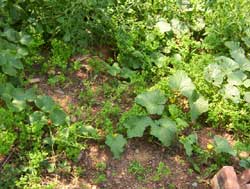Garden of Weedin'
By Jos Van Hage

It may not be everybody’s favorite chore but weeding the garden is an important chore that needs to be done in order to keep vegetables and flowers growing healthy.
Weeds take away important nutrients and moisture from the wanted plants as well as hide insects and disease.
The key to successful weed control is staying one step ahead of the weeds. It is much easier to go through the garden every couple of weeks with a hoe and get rid of the weeds when they are young rather than let them get large. The larger the weed the larger the root system and if you let them mature they will produce seeds which in turn will produce more weeds.
There is a saying that goes “One years seeding means 7 years weeding.”
When a weed flowers, and produces seed it can sow as many as 10,000 seeds which will come up in weeds over the next few years. The seed of chickweed can lay dormant in the soil for up to 7 years and be brought up to the surface of the soil where it will sprout and produce a plant.
Depending on the type of weed and where the weed is growing will determine how to get rid of the weed.
There are perennial weeds and annual weeds. Perennial weeds are those that have a large fleshy root or a runner and these will come back every year from the root. Annual weeds have a small developing root system with no runners and these spread by seed.
To get rid of perennial weeds you either dig them up with a weed puller or fork, or if they are in the lawn you may have to go to a chemical containing 2,4-D, Mecoprop, or Dicamba. Perennial weeds that have underground runners such as quack grass or Canadian thistle will spread if they are not dug up entirely so the best way to get rid of them if they are in the garden, is to spray them with a chemical called glyphosate which is in ‘Roundup’. The thing to watch for when spraying with ‘Roundup’ is that it will kill any plant it touches so you need to be careful when using it, but as soon as it touches the soil it is inactive and so will not kill any dormant seed or roots beneath the soil. Annual weeds are easier to get rid of, by simply hoeing them every couple of weeks.
You can help control weeds and limit their growth by prevention.
Using a ground cover such as landscape fabric will drastically cut down on weeds. This is ideal for areas where you plan on planting trees and shrubs. It is a woven black plastic sort of blanket that is placed on the ground just before you are ready to plant. It allows all the moisture and nutrients to go through but prevents weeds from coming up through it. You cut holes in the fabric where you want to dig a hole and plant the tree/shrub and when it is all planted you cover the landscape fabric with bark mulch or decorative rock. This also helps in keeping the moisture in the soil.
A healthy lawn is weed-free lawn. If a lawn is thick and healthy there is no room for weed seeds to get into the soil and germinate. Feeding the lawn with fertilizer and keeping it weed free in the beginning will give you a beautiful lawn for years to come.
The type of weed that grows in your garden can sometimes indicate other things going on in the soil. For example if you have a lot of chickweed this could mean that the soil is compact. Clover grows well in soils that have low fertility and are moist and yet in drought situations it will continue to thrive. Horsetail does well in poor soil, so by changing the soil conditions you can also reduce the weeds.
-Jos
Jos Van Hage operates three Art Knapp Garden Centres in Prince George:
-Highway 97 South at the Old Cariboo Highway
-Highway 97 North
-Highway 16 West
Previous Story - Next Story
Return to Home









